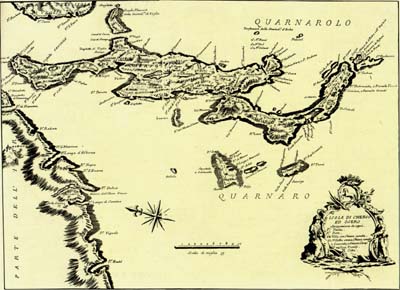
The islands Cres nad Losinj on the map Isola di Cherso ed Osero from 1771 by Alberto Fortis
| FORTIS, Alberto, (October 11, 1741, Padua - October 21, 1803, Bologna), theologian, biologist and travel writer. As a youth Fortis entered Paduan junior seminary and then the Augustinian order. He studied languages and sciences in Rome. Fortis travelled all over Europe, in particular across Italy and Dalmatia. He explored the countryside, folk customs and poetry of Croatia. In 1756 and 1771 he stayed in Istria, in 1770 on the islands of Cres and Losinj, and in the period from 1771 to 1774 and later paid several visits to Dalmatia, in particular to the area of Dubrovnik (1779-83). During his stays in Croatian areas he made friends with a large number of educated people, who provided him with data, in particular geographic and ethnographic, on Dalmatia. His first book about Dalmatia, Saggio d'osservazioni sopra l'isola di Cherso ed Ossero (Debate and Considerations about the Island of Cres and Losinj) from 1771 contains the map Isola di Cherso ed Ossero whose author is Fortis himself. The map represents the island of Cres and Losinj with their waters at the scale of 1:144 000. The work Viaggio in Dalmazia (A Journey over Dalmatia) from 1774, consisting of two parts, is a result of a number of journeys and trips to the eastern coast of the Adriatic that Fortis undertook from 1771 to 1773. The book is a unique report from his journeys, written in the epistolary form. It describes the Croatian coast and its hinterland: in the first book there is an account of the area from Zadar to Sibenik and in the second of the area from Trogir to Makarska region. The first volume of the travel book A Journey over Dalmatia contains the map of the area of Zadar and Sibenik I Contadi di Zara, e di Sebenico and the second volume contains the map I Contadi di Trav Spalatro, e Macarska, il Primorie, e Narenta, Coll'Isole Aggiacenti, which represents the central Dalmatian area, from Rogoznica to Klek on the mainland and to the island of Vis on the sea. In one chapter of the book Fortis published the folk poem Hasanaginica which was later translated into German by Goethe who came across it in Fortis' book. Goethe's translation of Hasanaginica considerably contributed to the popularisation of Croatian folk poetry in the European intellectual circles. He was the first in Europe to turn the attention of the public to Croatia, in particular to its folk poetry. In 1779 Fortis held an inaugural lecture in the Economic Society of Split titled Della coltura del castagno da introdursi nella Dalmazia marittima e mediterranea (On the Cultivation of Chestnut and its Introduction into the Seaside and Inland Dalmatia). The first edition of the work was issued in 1780 in Naples and was reprinted in 1794 in Venice. Fortis left Split for Naples where he worked as court mineralogist, being engaged not only in research, but also in practical activities, for example as a reader of old chronicles and a maker of corographic maps, an expert who explores mineral resources of the Kingdom and proposes how to exploit them. In 1791, after a ten-year service at Naples court, Fortis returned to Padua. The translation of Viaggio in Dalmazia into the Croatian language was published in Zagreb in 1984. |  The islands Cres nad Losinj on the map Isola di Cherso ed Osero from 1771 by Alberto Fortis |